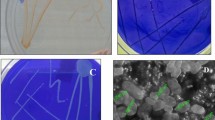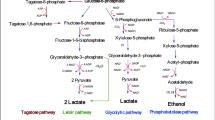Abstract
This study characterized the lipopeptide biosurfactants produced by lactic acid bacteria isolated from milk and milk products, in addition to their effect on maize plant growth. The oil displacement test was performed as a primary screening method to select the BS producing bacteria. The strain LM5.2 had the maximum emulsification index of 45.1 ± 3, reduced the surface tension to 32.98 ± 0.23% among all the isolates, and efficiently produced 945.26 ± 4.62 mg/l of biosurfactants within 48 h in MRS broth under the optimum conditions. The isolate LM5.2 was identified using physiochemical tests and 16S rRNA gene sequencing as E. faecium. The biosurfactant was purified by TLC and identified as lipopeptide-like iturins and surfactins based on Rf values. Mass spectroscopy, NMR, and FTIR analysis also confirmed the biosurfactant’s identity as the derivatives of iturin and surfactin. In vitro biosurfactant application significantly enhanced seedling growth at an optimal concentration of 450 µg/ml. Plant treatment (pot experiment) with E. faecium LM5.2 significantly promoted Zea mays growth compared to the control. To the best of our knowledge, this is the first report of lipopeptide biosurfactant production by E. faecium. Moreover, the study also showed that the biosurfactant and biosurfactant-producing E. faecium LM5.2 could be an eco-friendly plant growth-promoting agent.






Similar content being viewed by others
Data availability
Available upon request.
Code availability
Not applicable.
Abbreviations
- BS:
-
Biosurfactants
- EI24 :
-
Emulsification index
- TLC:
-
Thin layer chromatography
- ESI and APCI MS:
-
Electrospray ionization and atmospheric pressure chemical ionization mass spectrometry
- m/z:
-
Mass/charge
- FTIR:
-
Fourier transform infrared spectroscopy
- H1NMR:
-
Proton nuclear magnetic resonance
- Ppm:
-
Parts per million
References
Antonious E, Fodelianakis S, Korkakaki E, Kalogerakis N (2015) Biosurfactant production from marine hydrocarbon-degrading consortia and pure bacterial strains using crude oil as carbon source. Front Microbiol 6:1–14. https://doi.org/10.3389/fmicb.2015.00274
Arutchelvi JI, Bhaduri S, Uppara PV, Doble M (2008) Mannosylerythritol lipids: a review. J Indian Microb Biotechnol 35:1559–1570
Bais HP, Fall R, Vivanco JM (2004) Biocontrol of Bacillus subtilis against infection of Arabidopsis roots by Pseudomonas syringae is facilitated by biofilm formation and surfactin production. Plant Physiol 134(1):307–319. https://doi.org/10.1104/pp.103.028712
Balan SS, Kumar CG, Jayalakshmi S (2017) Aneurinifactin, a new lipopeptide biosurfactant produced by a marine Aneurinibacillus aneurinilyticus SBP-11 isolated from Gulf of Mannar: purification, characterization and its biological evaluation. Microbiol Res 194:1–9. https://doi.org/10.1016/j.micres.2016.10.005
Bhuvaneswari TV, Turgeon BG, Bauer WD (1980) Early events in the infection of soybean (Glycine max L. Merr ) by Rhizobium japonicum. Plant Physiology 66(709):1027–1031
Cawoy H, Mariutto M, Henry G, Fisher C, Vasilyeva N, Thonart P (2014) Plant defense stimulation by natural isolates of Bacillus depends on efficient surfactin production. Mol Plant Microb Interact 27:87–100
Chaurasia LK, Tamang B, Tirwa RK, Lepcha PL (2020) Influence of biosurfactant producing Bacillus tequilensis LK5. 4 isolate of kinema, a fermented soybean, on seed germination and growth of maize (Zea mays L.). 3 Biotech 10(297):1–12. https://doi.org/10.1007/s13205-020-02281-7
Dalili D, Amini M, Faramarzi MA, Fazeli MR, Khoshayand MR, Samadi N (2015) Isolation and structural characterization of Coryxin, a novel cyclic lipopeptide from Corynebacterium xerosis NS5 having emulsifying and anti-biofilm activity. Colloids Surf, B 135:425–432. https://doi.org/10.1016/J.COLSURFB.2015.07.005
de Lacerda JRM, da Silva TF, Vollú RE, Marques JM, Seldin L (2016) Generally recognized as safe (GRAS) Lactococcus lactis strains associated with Lippia sidoides Cham are able to solubilize/mineralize phosphate. SpringerPlus. https://doi.org/10.1186/s40064-016-2596-4
Desai JD, Banat IM (1997) Microbial production of surfactants and their commercial potential. Microbiol Mol Biol Rev 61:47–64
Dlamini B (2017) Downstream purification of surfactin produced by Bacillus subtilis ATCC 21332. Thesis-MEng, Stellenbosch University
Dusane D, Rahman P, Zinjarde S, Venugopalan V, McLean R, Weber M (2010) Quorum sensing; implication on rhamnolipid biosurfactant production. Biotechnol Genet Eng Rev 27:159–184
Fernandes PAV, de Arruda IR, dos Santos AFAB, de Araujo AA, Maior AMS, Ximenes EA (2007) Antimicrobial acitivty of surfactants produced by Bacillus R14 against multidrug-resistant bacteria. Braz J Microbiol 38:704–709
Frey-Klett P, Garbaye J, Tarkka M (2007) The mycorrhiza helper bacteria revisited. New Phytol 176(1):22–36. https://doi.org/10.1111/j.1469-8137.2007.02191.x
Gamalero E, Lingua G, Berta G, Glick BR (2009) Beneficial role of plant growth promoting bacteria and arbuscular mycorrhizal fungi on plant responses to heavy metal stress. Can J Microbiol 55(5):501–514. https://doi.org/10.1139/W09-010
Ghasemi A, Moosavi-nasab M, Setoodeh P, Mesbahi G (2019) Biosurfactant production by lactic acid bacterium Pediococcus dextrinicus SHU1593 Grown on different carbon sources : strain Screening followed by product characterization. Sci Rep 9(March):5287
Ghatani K, Tamang B (2017) Assessment of probiotic characteristics of lactic acid bacteria isolated from fermented yak milk products of Sikkim, India: Chhurpi, Shyow, and Khachu. Food Biotechnol 31(3):210–232. https://doi.org/10.1080/08905436.2017.1335212
Gudiña EJ, Teixeira JA, Rodrigues LR (2010) Isolation and functional characterization of a biosurfactant produced by Lactobacillus paracasei. Colloids Surf, B 76(1):298–304. https://doi.org/10.1016/j.colsurfb.2009.11.008
Habib S, Ahmad SA, Johari WLW, Shukor MYA, Alias SA, Smykla J, Saruni NH, Razak NSA, Yasid NA (2020) Production of lipopeptide biosurfactant by a hydrocarbon-degrading antarctic rhodococcus. Int J Mol Sci 21(17):1–21. https://doi.org/10.3390/ijms21176138
Han Q, Wu F, Wang X, Qi H, Shi L, Ren A (2015) The bacterial lipopeptide iturins induce Verticillium dahliae cell death by affecting fungal signalling signalling pathways and mediate plant defence responses involved in pathogen- associated molecular pattern-triggered immunity. Environ Microbiol 17:1166–1188
Jagtap S, Yavankar S, Pardesi K, Chopade B (2010) Production of bioemulsifier by Acinetobacter species isolated from healthy human skin. Indian J Exp Biol 48:70–76
Janek T, Łukaszewicz M, Krasowska A (2013) Identification and characterization of biosurfactants produced by the Arctic bacterium Pseudomonas putida BD2. Colloids Surf, B 110:379–386. https://doi.org/10.1016/j.colsurfb.2013.05.008
John WC, Ogbonna IO, Gberikon GM, Iheukwumere CC (2021) Evaluation of biosurfactant production potential of Lysinibacillus fusiformis MK559526 isolated from automobile-mechanic-workshop soil. Brazi J Microbiol: [publication of the Brazilian Society for Microbiol] 52(2):663–674. https://doi.org/10.1007/s42770-021-00432-3
Kumar S, Stecher G, Tamura K (2016) MEGA7: Molecular evolutionary genetics analysis version 7.0 for bigger datasets. Mol Biol Evolu 33(7):1870–1874. https://doi.org/10.1093/molbev/msw054
Li Y, Héloir M-C, Zhang X, Geissler M, Trouvelot S, Jacquens L (2019) Surfactin and fengycin contribute to the protection of a Bacillus subtilis strain against grape downy mildew by both direct effect and defence stimulation. Mol Plant Pathol 20:1037–1050
Ma Y, Kong Q, Qin C, Chen Y, Chen Y, Lv R, Zhou G (2016) Identification of lipopeptides in Bacillus megaterium by two-step ultrafiltration and LC–ESI–MS / MS. AMB Express. https://doi.org/10.1186/s13568-016-0252-6
Monnier N, Cordier M, Dahi A, Santoni V, Guénin S, Clément C, Sarazin C, Penaud A, Dorey S, Cordelier S, Rippa S (2020) Semipurified rhamnolipid mixes protect Brassica napus against Leptosphaeria maculans early infections. Phytopathology 110(4):834–842. https://doi.org/10.1094/PHYTO-07-19-0275-R
Morais IMC, Cordeiro AL, Teixeira GS, Domingues VS, Nardi RMD, Monteiro AS, Alves RJ, Siqueira EP, Santos VL (2017) Biological and physicochemical properties of biosurfactants produced by Lactobacillus jensenii P 6A and Lactobacillus gasseri P 65. Microb Cell Fact 16:155. https://doi.org/10.1186/s12934-017-0769-7
Penha RO, Vandenberghe LPS, Faulds C, Soccol VT, Soccol CR (2020) Bacillus lipopeptides as powerful pest control agents for a more sustainable and healthy agriculture: recent studies and innovations. Planta 251(3):70. https://doi.org/10.1007/s00425-020-03357-7
Pornsunthorntawee O, Wongpanit P, Chavadej S, Abe M, Rujiravanit R (2008) Structural and physicochemical characterization of crude biosurfactant produced by Pseudomonas aeruginosa SP4 isolated from petroleum-contaminated soil. Biores Technol 99(6):1589–1595. https://doi.org/10.1016/j.biortech.2007.04.020
Rahman KSM, Rahman TJ, McClean S, Marchant R, Banat IM (2002) Rhamnolipid biosurfactant production by strains of Pseudomonas aeruginosa using low-cost raw materials. Biotechnol Prog 18(6):1277–1281. https://doi.org/10.1021/bp020071x
Rodrigues MS, Moreira FS, Cardoso VL, de Resende MM (2017) Soy molasses as a fermentation substrate for the production of biosurfactant using Pseudomonas aeruginosa ATCC 10145. Environ Sci Pollut Res 24(22):18699–18709. https://doi.org/10.1007/s11356-017-9492-5
Ron EZ, Rosenberg E (2001) Natural roles of biosurfactants. Environ Microbiol 3(4):229–236. https://doi.org/10.1046/j.1462-2920.2001.00190.x
Sałek K, Euston SR (2019) Sustainable microbial biosurfactants and bioemulsifiers for commercial exploitation. Process Biochem 85:143–155. https://doi.org/10.1016/j.procbio.2019.06.027
Sachdev DP, Cameotra SS (2013) Biosurfactants in agriculture. Appl Microbiol Biotechnol 97(3):1005–1016. https://doi.org/10.1007/s00253-012-4641-8
Sambrook, Joseph, and Russel, D W (2006). Purification of nucleic acid by extraction with phenol: chloroform. In Cold Spring Harbor Protocols (p. 1).
Satpute SK, Kulkarni GR, Banpurkar AG, Banat IM, Mone NS, Patil RH, Cameotra SS (2016) Biosurfactant/s from Lactobacilli species: properties, challenges and potential biomedical applications. J Basic Microbiol 56(11):1140–1158. https://doi.org/10.1002/jobm.201600143
Sen S, Borah SN, Bora A, Deka S (2017) Production, characterization, and antifungal activity of a biosurfactant produced by Rhodotorula babjevae YS3. Microb Cell Fact 16(95):1–14. https://doi.org/10.1186/s12934-017-0711-z
Sharma D, Saharan BS, Chauhan N, Procha S, Lal S (2015) Isolation and functional characterization of novel biosurfactant producer by Enterococcus faecium. Springer plus 4(1):1–14
Silverstein RM, Webster FX, Kiemle DJ (2005) Spectrometric identification of organic compounds. 7th edn, Wiley, INC
Sriram MI, Kalishwaralal K, Deepak V, Gracerosepat R, Srisakthi K, Gurunathan S (2011) Biofilm inhibition and antimicrobial action of lipopeptide biosurfactant produced by heavy metal tolerant strain Bacillus cereus NK1. Colloids Surf, B 85(2):174–181. https://doi.org/10.1016/j.colsurfb.2011.02.026
Tamang B, Tamang JP (2010) In situ fermentation dynamics during production of gundruk and khalpi, ethnic fermented vegetable products of the Himalayas. Indian J Microbiol 50(October):93–98. https://doi.org/10.1007/s12088-010-0058-1
Tiwary M, Dubey AK (2018) Characterization of biosurfactant produced by a novel strain of Pseudomonas aeruginosa, isolate ADMT1. J Surfactants Deterg 21(1):113–125. https://doi.org/10.1002/jsde.12021
Van Hamme JD, Singh A, Ward OP (2006) Physiological aspects Part 1 in a series of papers devoted to surfactants in microbiology and biotechnology. Biotechnol Adv 24:604–620
Vatsa P, Sanchez L, Clement C, Baillieul F, Dorey S (2010) Rhamnolipid biosurfactants as new players in animal and plant defense against microbes. Int J Mol Sci 11:5095–5108
Velraeds, M M, van der Mei, H C, Reid, G, & Busscher, H J (1996) Inhibition of initial adhesion of uropathogenic Enterococcus faecalis by biosurfactants from Lactobacillus isolates. Appl Environ Microbiol 62(6):1958–1963. http://www.ncbi.nlm.nih.gov/pubmed/8787394
Vos P De, Garrity GM, Jones D, Krieg NR, Ludwig W, Rainey FA, Schleifer K-H, Whitman WB (2009) Bergey’s manual of systematics bacteriology second edition volume three the firmicutes. Springer, Dordrecht Heidelberg, London, New York
Yamamoto S, Shiraishi S, Suzuki S (2015) Are cyclic lipopeptides produced by Bacillus amyloliquefaciens S13–3 responsible for the plant defence response in strawberry against Colletotrichum gloeosporioides? Lett Appl Microbiol 60:379–386
Yilmaz F, Ergene A, Yalcin E, Tan S (2009) Production and characterization of biosurfactants produced by microorganisms isolated from milk factory wastewaters. Environ Technol 30(13):1397–1404. https://doi.org/10.1080/09593330903164528
Youssef NH, Duncan KE, Nagle DP, Savage KN, Knapp RM, Mclneney MJ (2004) Comparison of methods to detect biosurfactant production by diverse microorganisms. J Microbiol Methods 56(3):339–347. https://doi.org/10.1016/j.mimet.2003.11.001
Acknowledgements
Authors acknowledge Sikkim University for providing a UGC Non-NET fellowship to Lalit Kumar Chaurasia to carry out this research. The authors are also thankful to Dr Rajesh Kumar Khulbe, Senior Scientist, ICAR-Vivekanand Parvatiya Krishi AnusandhanSansthan, Almora, India, for providing “Vivek Maize Hybrid 53” seeds for the experiments.
Funding
No funding was received for this study.
Author information
Authors and Affiliations
Contributions
LK Chaurasia: contributed to the design and carried out the experiments. RKT: contributed to the isolation of lactic acid bacteria and identification. BT: helped in the design of the work and in writing the manuscript.
Corresponding author
Ethics declarations
Conflict of interest
The authors declare that they have no conflict of interest.
Ethical approval
This article does not contain any study with human participants and animals performed by any of the authors.
Consent to participate
Not applicable.
Consent for publication
Not applicable.
Additional information
Communicated by Erko Stackebrandt.
Publisher's Note
Springer Nature remains neutral with regard to jurisdictional claims in published maps and institutional affiliations.
Supplementary Information
Below is the link to the electronic supplementary material.
Rights and permissions
About this article
Cite this article
Chaurasia, L.K., Tirwa, R.K. & Tamang, B. Potential of Enterococcus faecium LM5.2 for lipopeptide biosurfactant production and its effect on the growth of maize (Zea mays L.). Arch Microbiol 204, 223 (2022). https://doi.org/10.1007/s00203-022-02834-9
Received:
Revised:
Accepted:
Published:
DOI: https://doi.org/10.1007/s00203-022-02834-9




